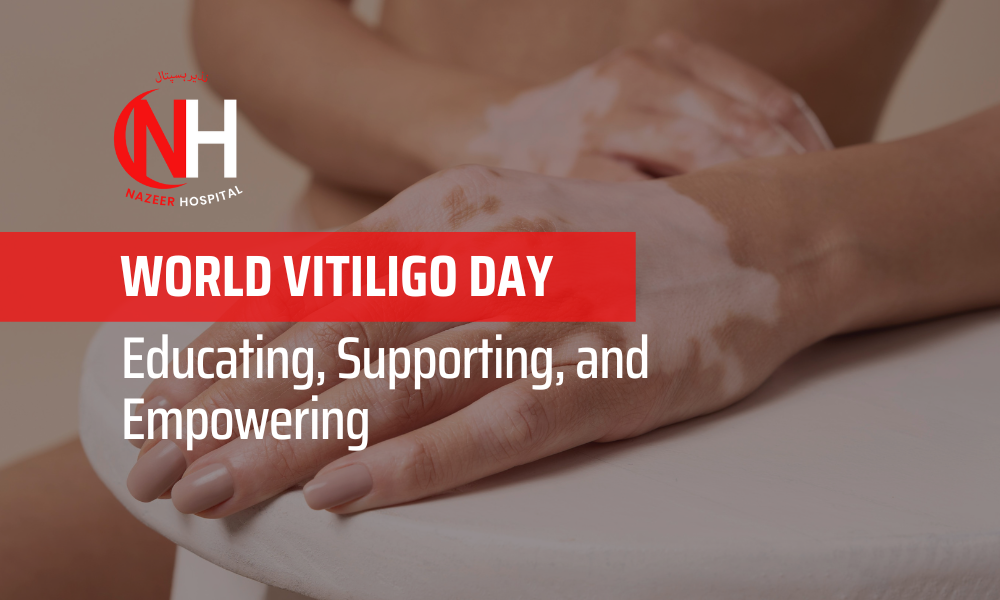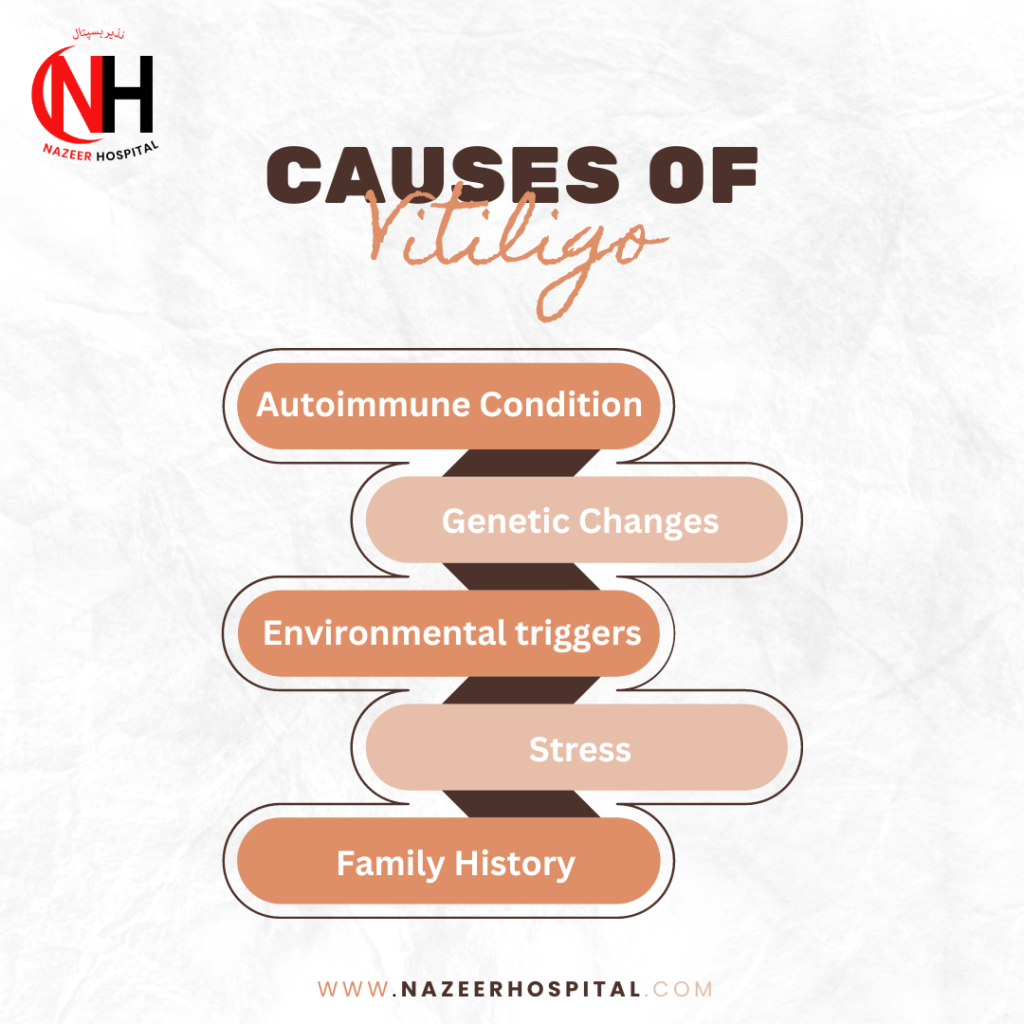World Vitiligo Day: Educating, Supporting, and Empowering
Updated on June 25, 2023

World Vitiligo Day, commemorated annually on June 25th, serves the purpose of increasing awareness regarding Vitiligo, a chronic skin condition distinguished by the depigmentation of patches on the skin. The day serves as a platform to educate the public, challenge misconceptions, and support individuals living with Vitiligo. With the theme “Embrace Diversity,” World Vitiligo Day 2023 emphasizes acceptance and understanding. This article explores the history, types, causes, symptoms, and treatment options for Vitiligo, debunking common myths along the way.
History & Significance of World Vitiligo Day
World Vitiligo Day was established in 2011 by a group of vitiligo patients who wanted to unite people worldwide to advocate for increased awareness and support. The date, June 25th, holds special significance as it marks the birthday of Michael Jackson, a renowned musician who publicly shared his struggle with Vitiligo.
The day aims to address Vitiligo’s emotional and psychological impact, provide community and empowerment to those affected, and foster research efforts to find better treatment options and, ultimately, a cure.
Types of Vitiligo
Vitiligo can be categorized into different types based on the pattern and extent of depigmentation. The most common types include:
- Non-segmental Vitiligo: This type is characterized by symmetrically distributed patches on both sides of the body, commonly affecting the face, hands, and joints.
- Segmental Vitiligo: Segmental Vitiligo typically affects only one side or specific body area and tends to develop at an early age.
- Universal Vitiligo: This rare type involves widespread depigmentation, covering a large portion of the body, including the face, trunk, and limbs.

What Are the Risk Factors of Vitiligo?
While Vitiligo can affect anyone, certain factors may increase the risk of developing the condition:
- Family history: Individuals with a family member affected by Vitiligo are more likely to develop the condition.
- Autoimmune diseases: Individuals with autoimmune disorders such as thyroid disease, type 1 diabetes, or alopecia areata are at an elevated risk of developing Vitiligo.
- Skin type: Vitiligo is more noticeable in individuals with darker skin tones but can affect people of all ethnic backgrounds.
What Are the Symptoms of Vitiligo?
The primary Vitiligo symptoms is the appearance of depigmented patches on the skin. These patches are usually pale or white and have a distinct border; they can vary in size and shape and commonly occur in areas exposed to the sun, such as the face, hands, arms, and feet. Other symptoms may include premature graying of hair, loss of color in the mucous membranes, and sensitivity to the sun.
Common Myths about Vitiligo
Myths and misconceptions often surround Vitiligo. Let’s debunk some of the most common ones:
Myth: Eating certain foods like fish and milk can cause or worsen Vitiligo.
Fact: There is no scientific evidence linking specific foods to the development or progression of Vitiligo. While maintaining a balanced diet is crucial for overall health, it does not directly impact Vitiligo.
Fact: There is no scientific evidence linking specific foods to the development or progression of Vitiligo. While maintaining a balanced diet is crucial for overall health, it does not directly impact Vitiligo.
Myth: Vitiligo is a result of poor hygiene.
Fact: Vitiligo has no connection with personal hygiene practices. It is an autoimmune condition affecting the pigmentation of the skin.
Fact: Vitiligo has no connection with personal hygiene practices. It is an autoimmune condition affecting the pigmentation of the skin.

Vitiligo Treatment Options
While there is no known cure for Vitiligo, several treatment options can help manage the condition and improve the appearance of the skin. These include:
- Topical corticosteroids: These creams or ointments help reduce inflammation and pigment in the affected areas of the skin.
- Topical calcineurin inhibitors:These medications modulate the immune response and can be effective for localized Vitiligo.
- Phototherapy: Ultraviolet (UV) light therapy, either narrowband UVB or excimer laser, can stimulate depigmentation.
- Depigmentation: In cases of extensive Vitiligo, depigmentation may be an option to lighten the remaining pigmented areas to achieve a more uniform appearance.

Vitiligo treatment in Pakistan is readily available, offering diverse options to effectively manage the condition and enhance the appearance of the affected skin.
One standard treatment option for vitiligo in Pakistan is topical creams or ointments. These creams may contain corticosteroids, tacrolimus, or psoralen, which can help stimulate depigmentation in the affected areas.
In addition to topical treatments, phototherapy is another commonly employed method for vitiligo treatment in Pakistan. Phototherapy involves exposing the affected skin to specific wavelengths of ultraviolet (UV) light, either narrowband UVB or targeted excimer laser. This light therapy can stimulate melanin production and promote depigmentation in the depigmented patches.
Conclusion
World Vitiligo Day serves as a reminder to embrace diversity, challenge stigmas, and support those affected by Vitiligo. By spreading awareness about the condition, debunking myths, and fostering research, we can create a more inclusive society where individuals with Vitiligo are celebrated for their uniqueness. Remember, with understanding and compassion; we can make a difference and promote acceptance of all skin colors and conditions.
Frequently Asked Questions
Vitiligo can be classified into various types based on the pattern and extent of depigmentation. The most common types include:
- Non-segmental Vitiligo: This type is characterized by symmetrically distributed patches on both sides of the body, commonly affecting the face, hands, and joints.
- Segmental Vitiligo: Segmental Vitiligo typically affects only one side or specific body area and tends to develop at an early age.
- Universal Vitiligo: This rare type involves widespread depigmentation, covering a large portion of the body, including the face, trunk, and limbs.
Yes, Vitiligo Awareness Month is observed in June. Throughout this month, various organizations and communities worldwide strive to raise awareness about World Vitiligo Day, educate the public, and support individuals living with the condition.
Presently, a cure for Vitiligo is not yet known. Nevertheless, treatment options exist that can effectively manage the condition and enhance the appearance of the affected skin. These treatments focus on depigmentation, which aims to restore color to the depigmented patches. Treatment options may include topical corticosteroids, topical calcineurin inhibitors, phototherapy, and in some cases, depigmentation.
No, Vitiligo is not contagious. It is not caused by any infectious agent or transmitted through physical contact. Vitiligo is characterized by the immune system’s erroneous attack and destruction of melanocytes, the cells responsible for skin pigmentation, manifesting depigmented patches.
Vitiligo can develop on any body part, but certain areas are more commonly affected. The patches of depigmented skin often appear on sun-exposed areas such as the face, hands, arms, feet, and areas around body openings like the eyes, nostrils, mouth, and genitals. However, Vitiligo can occur on any skin surface, including the scalp, knees, elbows, and mouth. The distribution and extent of vitiligo patches can vary from person to person.
Dr. Summayya Khalid

M.B.B.S, FCPS (Part 1) – Medicine and Allied
I am Graduated From Foundation University, Islamabad. I have a working experience at Fauji Foundation Hopsital, Rawalpindi and Anwar Hospital, Rawalpindi.
I am fully licensed, highly passionate and determined medical practitioner with a empathetic and professional attitude having strong clinical abilities combined to providing patients with the best care possible. I am skilled in handling paediatric, gynaecological & obstetric emergencies as well.
I also participated in various conferences and seminars and achieved certificates. I am a motivated team leader with strong organization and prioritization abilities, I have organized and participated in health camps in remote areas.
I am fully licensed, highly passionate and determined medical practitioner with a empathetic and professional attitude having strong clinical abilities combined to providing patients with the best care possible. I am skilled in handling paediatric, gynaecological & obstetric emergencies as well.
I also participated in various conferences and seminars and achieved certificates. I am a motivated team leader with strong organization and prioritization abilities, I have organized and participated in health camps in remote areas.

